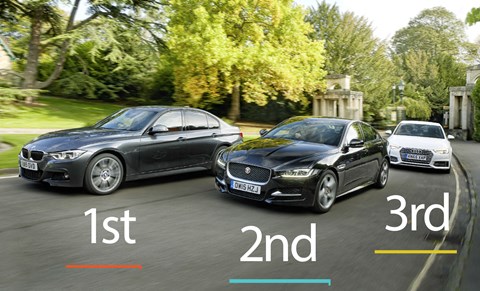► Audi’s new A4 takes on tough competition
► BMW’s updated 3-series comes with xDrive
► Fighting for the Brits is Jaguar’s XE
If you’re of the opinion that a car’s engine is its heart, soul and reason for being, now’s the time to either stick to your guns and walk away or consider giving a little ground. While the modern 2.0-litre turbodiesel four is many things – fuel efficient, gutsy, pretty refined and flexible of delivery – it is not a thing of charm. If some engines can be so electrifying in their response, delivery and soundtrack as to appear alive, shrieking to stratospheric redlines as they raise goosebumps like molehills on your arms – more orchestras than benign collections of rods, castings and gears – the turbodiesel four struggles to deliver much magic with its motive power.
That’s not the point, of course. Much more crucial are the low CO2 emissions required for favourable tax, not to mention the frugality and range to spend whole days on the road stopping only for Starbucks, M&S falafel and comfort breaks. But where does that leave you and I, rare creatures for whom an emotional connection to their transport is all-important? How should the sports saloon best deal with such an unpromising start? Smother the engine away and distract you with toys? Deliver a chassis so engaging you fail to notice the engine? Little bit of both?
On the evidence of the new A4, Audi feels that since a 2.0-litre TDI four (other engines are available of course, from a 99g/km CO2, 148bhp petrol 1.4 to an imperious 268bhp TDI V6) can’t be engineered to make your soul sing, its machinations should be muffled into insignificance. At speed on the M4, Bath-bound, rain lashing across the Audi’s now slightly tauter, more chiselled prow like a land-locked Atlantic storm, there’s no sound but that of your chosen audio media, the distant roar of surface water being flung into wheel-wells and the steady, rhythmic bass-line of your own pulse. Engine noise only gets close to intrusive on cold start or during a full-throttle kick-down. Acoustic glazing (standard for the windscreen; a must-have £450 option on the side and rear windows) and a refined engine in a more streamlined form all contribute to the A4’s impressive inner calm; suitably technik solutions that avoid the weight penalty implicit in tonnes of sound-deadening material and a big tub of glue (this A4’s up to 120kg lighter than its predecessor).
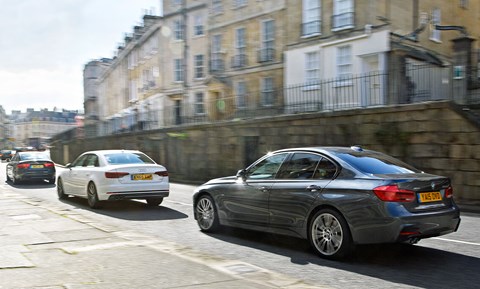
This tranquility suits the new A4’s interior very well, the luxurious absence of noise mirroring the cabin’s conspicuous paucity of anything cheap, ugly or nasty. The best interior here combines more generous accommodation (disappointingly, the Audi’s adequate rear legroom is unique in this company) with an economy of clutter,all-pervading light and a feel-good tactility to all that you interact with. Previously the universally praised king of intuitive MMI, Audi’s tweaked system might be progress but it doesn’t feel like it on first acquaintance. The principles remain the same, with an iDrive-style rotary controller flanked by buttons mirroring icons on either side of the menu page. But while the number of buttons has halved, their on-screen functionality is no longer labelled. Infuriatingly you can also dig pretty deeply into some menus, your full attention diverted from the road, only to be told your request is forbidden on the move.
With time you learn, of course, just as you also learn that the touchpad atop the rotary controller likes its letters written a certain way (part of the £1450 tech pack that also brings the multi-function steering wheel, upgraded nav and wireless phone charging), and that Virtual Cockpit (part of the £975 light and vision pack) is independent of the main screen and controlled from the steering wheel, so you’ll get no joy bringing up a phone number on the main display and then punching the call button on the wheel.
That said, Virtual Cockpit is so good, particularly during urban navigation, that once sampled its high-resolution brilliance and simple functionality render the main screen all but redundant. So you turn it off, especially at night, mostly to try to cut down on the wanton levels of light pollution in the cabin. With back-lighting to almost every control and feature on the dash, door and centre console, you fear being mistaken for a small town by passing pilots.
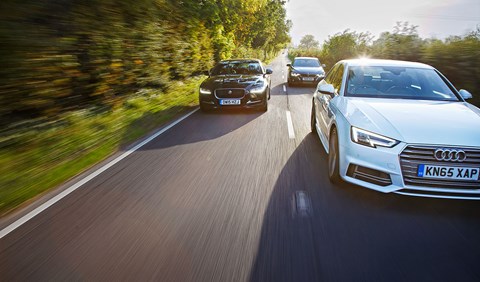
So far, so predictable; the A4 is refined, nice inside and spacious. But there is a surprise, and it’s the car’s new-found interest in driving. Being front-wheel drive the Audi ploughs its own furrow in this company, but crucially it’s now far less keen to simply plough on. Onlookers may enquire as to whether or not it’s the new model without a shred of conviction – blame the painfully evolutionary if not entirely unsuccessful exterior form – but from the driver’s seat you’re left in no such doubt. Where previously rapid progress on damp roads was an exercise in patience, blind faith and understeer management, the new A4 is communicative and talented. The front end, on this meatily-tyred S line example certainly, is impressively grippy and dependable, refusing to wash wide of your intended line even as you supply more and more excuses for it to do so. And when your ambition exceeds what’s possible the car’s response is nicely neutral, with an as-one shift to tuck the nose in as you come off the brakes and a willingness to accept full throttle but moments later without complaint.
Things can still get scrappy if you’re too keen to overlap steering and throttle but in front-wheel-drive form the new A4 is a rapid cross-country conveyance; composed, almost parental in its endless acts of forgiveness and not entirely unexciting. It also feels like the quickest car here, its weight advantage and slick transmission (avoid the ponderous, joy-free manual) lending A-road overtakes a welcome brevity. Yes in S line spec there’s still plenty of fidgeting on rougher roads and no, great swathes of slide-happy BMW pilots are unlikely to flock to their nearest Audi centre, but no longer must A4 drivers trade any interest in the act of driving for their comfort, refinement and on-point design.
Sadly, to an extent, XE fans must endure the reverse. Less than a year in and the Jaguar’s cockpit already feels ripe for a makeover. Harsh? Perhaps, and certainly there’s little overtly wrong with either the quality or functionality of the XE’s interior space (cosy rear quarters excepted) but so lofty are the standards set by the other two that the Jaguar falls conspicuously short. By miles? Not at all, but in every regard it’s a little less polished, a little more cost-conscious in feel, a little clunkier. The instrument display lacks anything approaching the clarity and dexterity of the Audi’s, while the accuracy and speed of iDrive shows up the intrinsic shortcomings of the Jaguar’s touchscreen, if not any specific flaw in its implementation.
So it’s a little basic, but the driving position fits like a hot bath; welcoming, nicely low-slung and endlessly comfortable, the XE gunning for snug and coupe-like while the A4 aims for New York loft. Get moving and you’re struck first by the engine’s relative lack of refinement in this company. It clonks into life like a con-rod’s kissed a bore (disarming stop/start becomes a reflex action) and communicates too much of its labours to the cabin, whether it’s midrange tremors or light-load whistles and bleats. Thankfully this is followed moments later by a nascent fondness for the unobtrusive deftness of the eight-speed gearbox and the brilliance – not too strong a word, honestly – of the chassis.
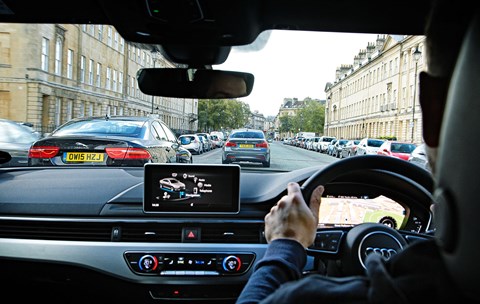
The steering may not be the last word in road-at-your-palms texture but it is perfectly weighted, reassuringly accurate and devoid of any confidence-sapping numbness. So when the hedges are close, the lines of sight tight and the corners unpredictable and blind the XE is king, feeling inches smaller than its German rivals thanks to the accuracy with which you can place the car and plot your course. Throw in a few ripples, ruts and lumps and the Jaguar moves further ahead, its suspension adroitly controlling wheel movement and checking its effect on the body. Where the A4 jitters down rough roads like a five-seat long-board, steering gently tugging this way and that, the Jaguar just flows. In this form the XE hasn’t the firepower to feel overtly rear-wheel drive but there’s balance and traction in spades, the car firing from even greasy corners with the ease you’d expect of a chassis also available with a 335bhp supercharged V6.
Once you’ve clocked the XE’s dynamic fluency it doesn’t take long to grow to really admire it; that supple ride wedded to the meaty, incisive sensation of the front tyres setting the car onto a new course with every tiny input of the wheel – no delay, no doubt. It’s a superiority born of the XE’s unique-in-class double-wishbone front suspension and, presumably, some very sweetly judged calibration. After a run in the Jaguar both Germans feel standoffish and needlessly fidgety. Lob in that great driving position and seamless auto (preferably paired with the optional metal paddleshifters) and the XE cements its position as the new 3-series when it comes to outright driver appeal: truly the Jaguar is a sports saloon to buy with your heart.
But what of the actual 3-series, 40 years on from the quiet revolution of the brilliant E21’s arrival? The blink-and-you’ll-miss-them changes for 2015 may be subtle – revised lights, upgraded interior materials, auto-blipping on manual gearboxes, smoother shifts for the autos, strengthened suspension, revised damper and steering settings – but they also demonstrate the kind of fastidious, laser-focused self-improvement that’s kept the 3-series at the top pretty much for as long as the model’s existed.
While the BMW can’t match the Audi for bank-vault NVH, road and engine noise are better suppressed than they are in the Jaguar and, what’s more, the 3-series steals a helpful headstart by being blessed with the least diesel-like engine to start with. In refinement, the noises it makes and the nature of its power delivery the BMW motor is the least overtly diesel, if not quite as adept at impersonating a petrol as Munich’s bigger sixes.
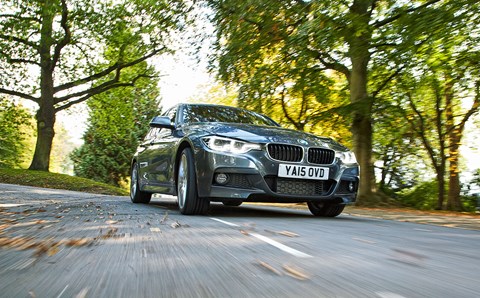
So immediately you’re happy, and thinking this might be some best-of-both-worlds magic bullet. Inside the mood is serious – straight-cut fringe after the Audi’s light, bouncy tresses – but there’s much to like: cuddly, supportive seats; just-so driving position; exquisitely textured rubber – steady – on the door pulls; the shift lever that fits so beautifully in the hand you can almost feel the clay prototype; paddleshift levers that feel i8 expensive. The steering wheel’s too fat of rim of course, but the system itself is sweet; direct, weighty and devoid of the corruption or numbness that are often bundled with four-wheel drive whether you want them or not.
The BMW’s ride quality can’t match the Jaguar’s – on dull roads you find yourself prodding through the drive mode menu to Comfort, hoping the system’s connected to the dampers. For £515 it can be, but even then they can’t fully anaesthetise the fidgeting in the same way the system so effectively removes all signs of life from the powertrain. But the payoff is impressive body control and apparently unimpeachable poise under duress. If the BMW doesn’t arc into corners with quite the same puppy-dog enthusiasm as the XE it’s not far behind, and counters with an even more stoic refusal to roll. The 3-series simply rails around empty roundabouts and down challenging roads with all the speed and composure you could wish for, the essential balance afforded by the car’s rear-drive platform working with xDrive to ensure at times quite astonishing speed without fuss. Is a 3-series with driven front wheels blasphemy? Possibly, for a committed few, but for everyone else it’s an impressively deft and unobtrusive all-wheel-drive system, one that gives much of the feel of a rear-drive chassis without the potential to find yourself pointing the wrong way. While absent on this Audi, experience suggests the A4’s quattro set-up is similarly accomplished but in both cases feel free to save some money and dismiss them as superfluous.
Of course the A4’s never been about charging around. But its new-found dynamic fluency adds another layer of gloss to its already lustrous desirability. The weight reduction, much of it from the steering and suspension systems, plus the latter’s rigid five-link set-up have combined to finally breathe life into the Audi option. The A4 is a clever, nicely wrought and satisfyingly resolved product. Its approach to the turbodiesel problem is compelling. You’re undoubtedly less prone to moan about binary throttle response and an uninspiring power delivery when the nav display feels like flying and the cabin’s plush like something plucked from a considerably saltier price bracket. But still the Audi feels a little too cool and aloof, certainly in this company.
Not so the Jaguar. It’s a mark of the car’s ride and handling brilliance (and the engine’s lack of refinement…) that nowhere does the four-pot turbodiesel feel less satisfying than here. But you will find yourself having too much fun to care, and to hell with some less-than-luxe interior plastics.
And the BMW? A painfully obvious winner perhaps but the weak areas in its game have been relentlessly weeded out and rectified. It’s close, and the XE and A4 (not to mention Mercedes’ unchanged but compelling C-class) scrutinise the 3’s superiority like never before, but by blending the finer attributes of its rivals the BMW wins out.
Key Tech
Audi A4: efficiency assist

Claiming the potential to reduce thirst by 10%, the A4’s optional predictive efficiency assistant works with the adaptive cruise control to achieve more parsimonious progress where possible, backing off the throttle ahead of junctions and tighter corners and coasting if it decides you can afford to do so. On cars without adaptive cruise the nav and traffic sign recognition still evaluate the road ahead, flashing up a green foot-on-the-gas icon to suggest you ease off, you speed-hungry planet-wrecker. Mildly patronising perhaps, but you can’t fault the tech or the motive behind it.
BMW 320d: xDrive
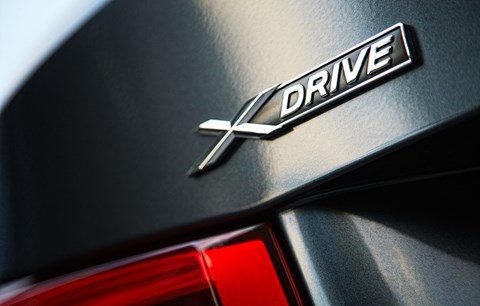
The 3-series’ four-wheel drive runs a 40:60 front/rear drive split until provoked, when the car can shunt almost all the available drive to the front or rear axle as required to fight wheelspin, oversteer or understeer. The result is a more neutral, hooked-up drive. While there are price (£1500), weight (85kg), CO2 (10g/km) and efficiency (5.3mpg) penalties, the payoff is a very versatile 3-series. A4 can be had with quattro, naturally. XE relies on traction electronics.
Jaguar XE : InControl apps
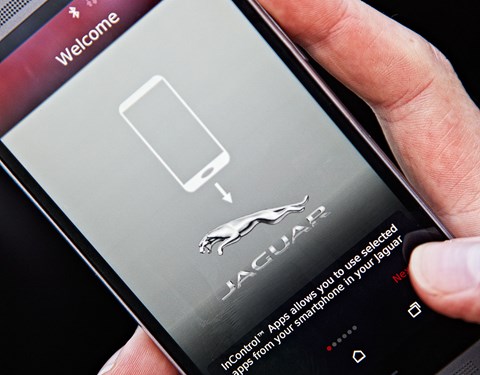
Get in the Jag and, rising gear selector aside, you’d be forgiven for wondering where the modernity was happening. But there is a bit of cutting edge tech hidden on page two of the infotainment system: InControl Apps. Plug in an appropriately apped-up smartphone and you get instant on-screen access to your contacts list, music and calendar, with the option to add extras such as Stitcher for podcasts and CitySeeker for comprehensive point of interest info. Sounds gimmicky, but works compellingly well.
A closer look
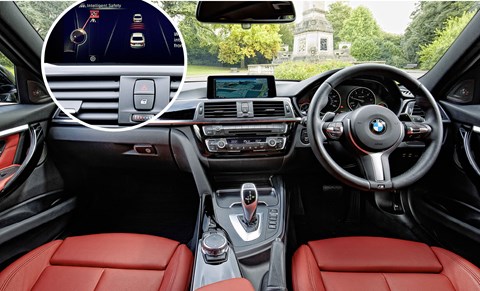
Auto or DIY? Expensive-feeling shift levers and a gearlever that’s the right way round (forward for down) encourage a hands-on approach to gear selection. Go manual to save £1690.
Grasp the python. F30 sticks with 3-series tradition; fat steering wheel rim, great ergonomics and a dash that’s gently pushing back towards being driver-centric.

Not iDrive! Jaguar Land Rover’s rotary gear selector has its haters but it works well and looks and feels classy. By contrast the touchscreen suffers a little with turbo lag, but you’ll live.
Seat of the pants. Great driving position and brilliant steering shine from the moment you move away. General ambience doesn’t, but class standards are seriously high.

Sound of quality. Mute the audio to enjoy refinement you had to buy a Rolls for not all that long ago. Bang & Olufsen stereo upgrade inessential but superb.
R8 steering! In the design of the wheel at least, if not quite in action. Master its controls and, together with Virtual Cockpit, the main screen becomes almost superfluous.
The result
1st – The complete all-rounder works briliantly in every regard. A little po-faced perhaps, but topping a class this competitive is no laughing matter
2nd – Lacks refinement and interior flair but punches back hard with superb ride and steering. A 21st century MkII of sorts, and a genuinely sporty sports saloon
3rd – Like a politically correct school sports day, they’re all winners. A4 better to drive than ever before, spacious, clever and desirable
